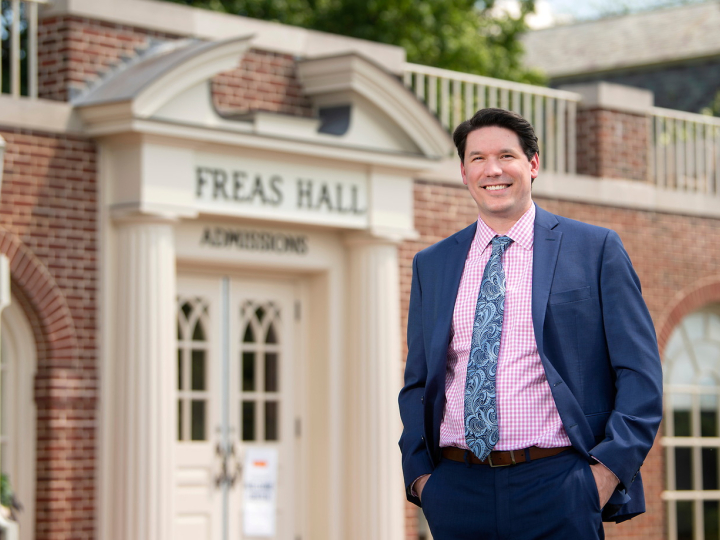Student Project Uncovers Numerous Opportunities For Engagement With River
July 1, 2016
The St. George Street Landing sits just a few blocks from the edge of Bucknell University's campus. An access point to the Susquehanna River, it could easily go unnoticed to those passing by, but Sam Pearson, executive director of the Lewisburg Neighborhoods Corp. (LNC), sees opportunity.
"There's great potential for developing more canoe and kayaking opportunities," said Pearson, who leads the local nonprofit, which pursues neighborhood revitalization through cooperative efforts. "There could be gazebos or hammocks on the flat area that's just grass now, and it could also be used for small-scale planting to assist in stopping the invasive plant species coming in along the bank."
Thanks to the efforts of a trio of recent Bucknell graduates, Pearson confirmed her hunch that many members of the Lewisburg community share those same ideas for improvements to the St. George Street Landing. In fact, they are just a small sampling of the suggestions collected through a public survey (which remains open) that Traci Eschbach '16, Amanda Fazio '16 and Meghan Reilly '16 developed and conducted for their community projects course (ENST 411) this spring.
The project's purpose was to assess the public's attitudes and perceptions about the river and provide a foundation for the LNC's River Town team to make future decisions on improving, developing or better utilizing five public sites adjacent to the river and its Buffalo Creek tributary — Wolfe Field, Lewisburg Community Garden, Soldiers Memorial Park, Mariah's Garden and the St. George Street Landing, site of the annual Polar Bear Plunge.
The Susquehanna Greenway Partnership granted River Town status to Lewisburg in 2014. Each municipality must complete certain requirements to maintain that status, one of which is to develop a plan, based on public input, for utilizing areas along the river and its tributaries. The River Town team, which is made up of volunteers, was established to assist in fulfilling these requirements. Due to funding and personnel limitations, certains areas of these requirements, such as planning, have developed slowly. This is where the student group stepped in to assist.
In addition to the survey, the project also involved extensive research on the history of those sites through collaboration with several stakeholders, attendance at several public events, meetings and focus groups, and a charrette that the students organized.
Previous efforts of public outreach and improvement to those sites were largely fragmented, but the students' work produced results: a compilation of information that will serve as both a roadmap and future reference material for the River Town team. It also sped up the group's planning process by six to 12 months.
"There are lots of potential uses and opportunities across the entire waterfront. We came out of this with a task list, which was previously a huge hurdle to get over," said Pearson. "The students really got us to this point. If we didn't have their help, we were looking at doing a public survey in the fall, and I can guarantee it would have been less ambitious out of necessity due to our limitations.
"The students really amplified this process and reached a more diverse group of people through greater outreach efforts than we would have if we had done everything ourselves. This allows us to get organized and really target the grants we want to seek in the future."
The ENST 411 course is required for all environmental studies and environmental science majors, and geography majors can also take it for their culminating experience requirement. In addition to the positive impact on the LNC and the greater community, all three students gained invaluable experience that they will take with them as they embark on their careers.
"It really brought together everything we've learned in our majors and allowed us to put it into a practical use," said Eschbach, who hopes to establish a career in environmental activism and conservation. "It was a great experience for bridging the gap from Bucknell to our future careers."
Fazio, who shares similar career goals, agreed. "I think you can only be challenged so far in the classroom, but once you get put into a situation where what you do matters in a bigger picture and the community, it really motivates you even more to do a good job not just for yourself but also for that other person counting on you," she said. "I think a lot of environmental change comes from small communities like Lewisburg, and I think this project illustrated that."
In the fall, Reilly will begin pursuing a graduate degree from the College of Charleston, with aspirations of becoming a marine biologist. This experience helped her see her field from a different perspective.
"Coming from more of a natural science background, we sometimes can get too focused on our research and don't realize or forget how our work can or should connect to the community, so I gained a little more perspective on the social aspects that go into a project like this," said Reilly. "Having that as a background for how to carry myself in my future career will be beneficial."
Professor Amanda Wooden, environmental studies, who taught the course for the first time this year, also lauded the trio for their efforts.
"The amount of time this group spent on the project went above and beyond expectations. I think having someone like Sam as a leader really generates the desire to do that much. These three students knew that going in and picked this project because they knew it would be intense and really wanted to make a positive contribution to the community, which they certainly did."
